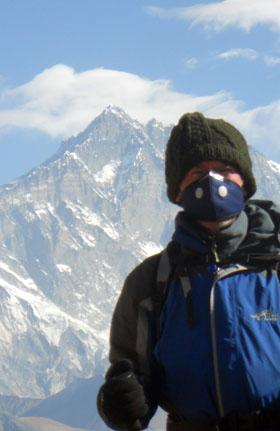 |
Prof. Lodewyk Kock at the Everest viewpoint with Mount Everest behind him.
10 January 2013 |
Profs. Lodewyk Kock and Robert Bragg from the Department of Microbial, Biochemical and Food Biotechnology at the University of the Free State (UFS) both presented lectures at the first International Conference on Infectious Diseases and Nanomedicine that was held in Kathmandu, Nepal, late last year.
At the conference, also attended by senior representatives from the International Union of Microbiological Societies (IUMS), Prof. Kock delivered one of the two opening lectures, titled: Introducing New Nanotechnologies to Infectious Diseases (the other opening lecture was presented by Nobel Laureate, Prof. Barry J. Marshal). Prof. Kock also participated in the farewell address.
In two excellent lectures, Prof. Bragg spoke on Bacteriophages as potential treatment option of antibiotic-resistant bacteria, and on Bacterial resistance to quaternary ammonium compounds.
For Prof. Kock this very first conference on infectious diseases and nanomedicine was followed by a very exciting yeast research excursion through the Mount Everest Highway which winds through the villages of the Sherpa tribe.
He describes his journey: “The Mount Everest Highway is a rough road stretching through hills and glacial moraines of unfamiliar altitudes and cold temperatures. Throughout the journey I had to take care of not contracting altitude sickness which causes severe headaches and dizziness.
“The only way of transport is on foot, on long-haired cattle called Yaks, donkeys and by helicopter. After flying by plane from Kathmandu (the capital of Nepal), I landed at Lukla, regarded as the most dangerous airport in the world due to its short elevated runway and mountainous surroundings. From Lukla, the land of the Sherpa, I walked (trekked) with my Sherpa guide and porter (carrier) along the Everest Highway surrounded by various Buddhist Mani scripture stands, other Buddhist representations and many spectacular snow-tipped mountains of more than 6 000 m above sea level. Of these, the majestic mountain called Ama Dablam (6 812 m), the grand 8 516 m high peak of Lhotse and to its left the renowned Mount Everest at 8 848 m in height, caught my attention.
“Dwarfed by these mountain peaks on the horizon, I passed various villages until I eventually reached the beautiful village called Namche Bazar, the heart of the Khumbu region and hometown of the Sherpa. This took three days of up to six hours walking per day, while I spent the nights at the villages of Phakding and Monjo. From there I walked along the Dudh Kosi River which stretches towards Mount Everest, until I reached the high altitude Everest viewpoint – the end of my journey, after which I trekked back to Lukla to return to Kathmandu and South Africa.
“This expedition is the first exploration to determine the presence of yeasts in the Everest region. Results from this excursion will be used in collaborative projects with local universities in Nepal that are interested in yeast research.”